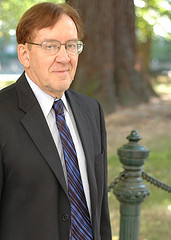About a month ago I had lunch with Ron Buel of Riverfront for People. He had an idea to share with the bike community and wanted to get some feedback.
I quickly found out that this wasn’t just any old idea…
Buel is one of several transportation visionaries behind a nascent effort to bury the I-5 freeway from the Marquam Bridge to the Banfield interchange.
This vision was drafted by a panel of 24 experts known as the Freeway Loop Advisory Group that was assembled in 2003 by Vera Katz and ODOT.
Their job was to review the near and long-term transportation, land use, and urban design issues regarding the I-5/405 freeway loop that surrounds downtown Portland on both sides of the Willamette.
Putting this major freeway into a tunnel — and even possibly burying the Marquam Bridge — is an immense and expensive undertaking, but it might be more feasible than you think…especially with Ron Buel and Riverfront for People spearheading the effort.
Buel got his start on Portland’s political scene way back in the 1960’s when he helped Neil Goldschmidt in his bid for City Commissioner. Buel’s impressive list of credentials includes founding the Willamette Week in 1974 and an executive position at Nike just to name a few.

Drawing courtesy Riverfront for People
And Riverfront for People? They’ve been advocating to remove the east bank freeway for over 20 years. And, if you know your Portland history, you’ll remember them as the group who rallied to get ODOT to tear up Harbor Drive and put Tom McCall Waterfront Park in its place.
Suffice it to say, the idea to put I-5 into a tunnel is far from just a pie-in-the-sky scheme.
So what would this mean for bicycles? Plenty.
Buel envisions bike boulevards criss-crossing the Central Eastside and giving direct, benzene-free access to the River.

It was clear in listening to Buel, that he wants this project to move forward because it would add to the cultural and economic vibrancy of Portland.
Buel also emphasized how this plan would cut congestion and reduce car trips in Portland. The plan calls for adding capacity to the freeway and — because many people that drive in Portland are commuting from outlying cities — a major part of their vision is to add thousands of close-in, “workforce” housing units enabling more people to walk and bike to work.
Other salient points in their vision include:
- Taking out the freeway and adjacent ramps to create 43 acres of land between the Banfield and OMSI along the riverfront.
- Restoring wildlife habitat in the river, on the bank, and back from the bank for a minimum of 100 feet, and make a major City Park similar to Waterfront Park on the West Side.
- Expanding the Eastbank Esplanade and adding bike boulevards along the river North-South and down to the River from the Central Eastside and adjoining neighborhoods.
- Major mass transit and pedestrian enhancements that offer greater access to the River
- Adding thousands of units of workforce housing to be built adjacent to what Buel called the “jobs zone” in the Central Eastside.

Drawing courtesy Riverfront for People
Buel and his group received a boost from City Council when they unanimously passed a resolution to study this idea as part of the Central City Plan Update that will begin in January 2007.
Before I left my meeting with Buel, he asked if I could present a few questions to get feedback from the bike community. Here are some questions for you to consider and share your thoughts on:
- Would you prefer to see a bike boulevard built running North-South along the river, or would you just like to see the Esplanade widened so cyclists and pedestrians could better share the space?
- Which streets running East/West down to the River through the Central Eastside seem best for future bike access to you if the freeway were removed?
- Would you participate as a cyclist in the Central City Plan Update public participation process?
As far-off and far-fetched as this idea may seem, this is the type of visionary thinking that we can’t be afraid to consider if hope to make Portland a great city for future generations.
Buel says if we start now it would only take 15 to 25 years to complete. I know politics and budgets rule the day but even if this plan gets stalled or shot down, I hope it succeeds in starting a dialogue that forces our city planners and elected officials to consider bold moves to make this city work better for people, not just for motor vehicles.
Further reading:
- Ron Buel’s testimony from the City Council hearing last month (it’s full of interesting details). (PDF)
- Freeway Loop Study from July 2005 (links to PDF)
- Article from Portland Tribune (October 5, 2006), Freeway thinkers dig deep for ideas
- A history of Riverfront for People by Portland State University
- Riverfront for People home page
- Ron Buel’s guest posting on the BlueOregon blog, Let’s put the East Bank freeway in a tunnel
- Good post and discussion on the Portland Architecture blog, All hail the loop group


